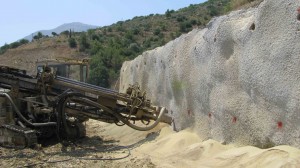Unstable soil, rock or combination of both materials, manifests in a land sliding mass when the driving forces are higher than the resisting forces. In essence a landslide forms when the shear strength providing the resisting force becomes smaller than the driving force which may be a combination of weight, external load etc. The usual conditions that trigger a landslide are the increase in water pressure which lead in a reduction of effective stress and shear strength.
The water or pore pressures increase when heavy or prolonged rainfall occurs or when snowmelt takes place. Unfortunately these conditions cannot be controlled and a long term prediction is not possible (rainfall prediction is of a couple of days at most and the magnitude (mm/day) not easily evaluated beforehand).
 Water seeps in the soil/rock mass and can increase the external pressure on the backside of an unstable mass (especially in rock slopes), can increase the pore pressures in the sliding surface, and can increase the weight of the soil mass.
Water seeps in the soil/rock mass and can increase the external pressure on the backside of an unstable mass (especially in rock slopes), can increase the pore pressures in the sliding surface, and can increase the weight of the soil mass.
It is very interesting to note that although the best way to stabilize a landslide may be by controlling the water pressures, engineers tend to ignore that and try to use more complex methods such as pile walls, ground anchors etc with questionable results. It would be great to have comments on this issue…
